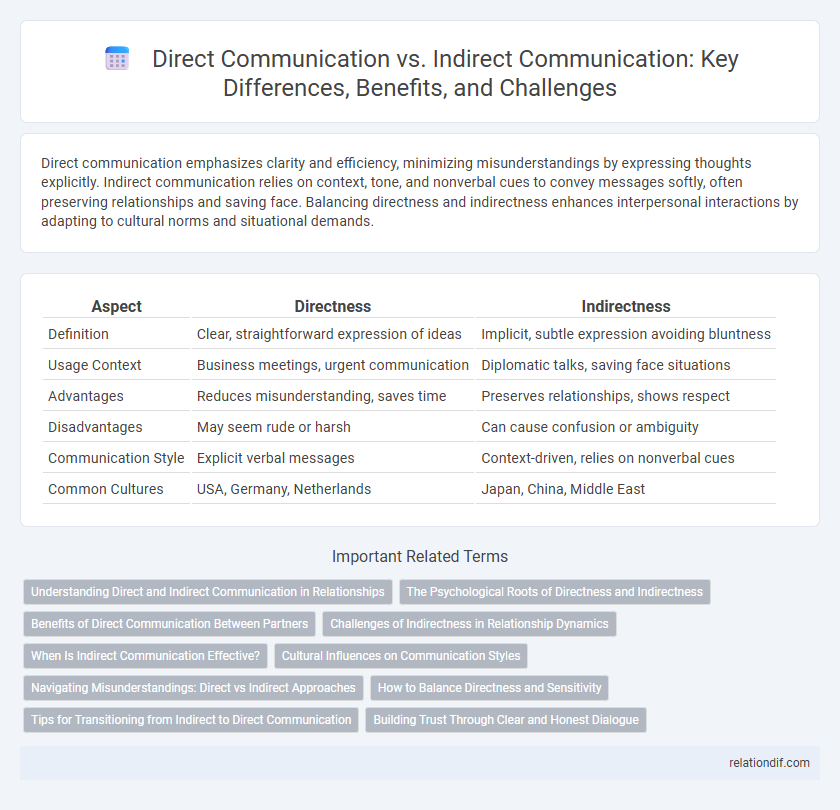Direct communication emphasizes clarity and efficiency, minimizing misunderstandings by expressing thoughts explicitly. Indirect communication relies on context, tone, and nonverbal cues to convey messages softly, often preserving relationships and saving face. Balancing directness and indirectness enhances interpersonal interactions by adapting to cultural norms and situational demands.
Table of Comparison
| Aspect | Directness | Indirectness |
|---|---|---|
| Definition | Clear, straightforward expression of ideas | Implicit, subtle expression avoiding bluntness |
| Usage Context | Business meetings, urgent communication | Diplomatic talks, saving face situations |
| Advantages | Reduces misunderstanding, saves time | Preserves relationships, shows respect |
| Disadvantages | May seem rude or harsh | Can cause confusion or ambiguity |
| Communication Style | Explicit verbal messages | Context-driven, relies on nonverbal cues |
| Common Cultures | USA, Germany, Netherlands | Japan, China, Middle East |
Understanding Direct and Indirect Communication in Relationships
Direct communication in relationships involves clear, explicit expressions of thoughts and feelings, reducing misunderstandings and enhancing trust. Indirect communication relies on implied meanings and nonverbal cues, often preserving harmony but risking ambiguity. Balancing direct and indirect styles improves emotional connection and conflict resolution in diverse relational dynamics.
The Psychological Roots of Directness and Indirectness
The psychological roots of directness and indirectness in communication stem from individual cognitive styles and cultural conditioning that influence how people encode and decode messages. Direct communicators often value clarity, efficiency, and confrontation as a means to resolve issues, reflecting traits like high self-confidence and low social anxiety. Indirect communicators tend to prioritize harmony, context, and relationship preservation, which are linked to higher sensitivity to social cues and a preference for avoiding conflict.
Benefits of Direct Communication Between Partners
Direct communication between partners enhances clarity, reduces misunderstandings, and fosters trust through transparent exchanges. By articulating thoughts and feelings openly, partners can swiftly address issues and strengthen emotional intimacy. This straightforward approach encourages accountability and promotes efficient problem-solving in relationships.
Challenges of Indirectness in Relationship Dynamics
Indirectness in communication often leads to misunderstandings and ambiguity, complicating conflict resolution within relationships. Subtle hints and implied meanings can cause frustration and emotional distance, as partners may struggle to interpret intentions accurately. This challenge undermines trust and can result in decreased relationship satisfaction over time.
When Is Indirect Communication Effective?
Indirect communication is effective in situations requiring cultural sensitivity, particularly in high-context cultures where preserving harmony and avoiding confrontation are prioritized. It allows for nuanced expression, enabling message recipients to infer meaning and read between the lines, which strengthens relationships and prevents offense. This method is especially useful in hierarchical organizations and diplomatic contexts where maintaining respect and discretion is crucial.
Cultural Influences on Communication Styles
Cultural influences play a crucial role in shaping communication styles, where directness is often valued in low-context cultures like Germany and the United States, emphasizing clarity and explicit verbal messages. In contrast, high-context cultures such as Japan and India prioritize indirectness, relying on nonverbal cues, context, and implicit understanding to preserve harmony and social hierarchy. Understanding these cultural differences enhances cross-cultural communication effectiveness by reducing misunderstandings and fostering mutual respect.
Navigating Misunderstandings: Direct vs Indirect Approaches
Direct communication reduces ambiguity by explicitly stating intentions, which minimizes the risk of misunderstandings in professional and personal contexts. Indirect communication relies on context and non-verbal cues, requiring high levels of cultural awareness to interpret accurately. Effective navigation between direct and indirect approaches involves recognizing the audience's preferences and adapting language to enhance clarity and relational harmony.
How to Balance Directness and Sensitivity
Balancing directness and sensitivity in communication requires clear expression of ideas while respecting the listener's feelings and cultural norms. Employing assertive language combined with empathetic tone ensures messages are understood without causing offense. Techniques such as active listening, choosing appropriate timing, and using "I" statements foster openness and minimize misunderstandings.
Tips for Transitioning from Indirect to Direct Communication
To transition from indirect to direct communication, start by practicing clarity and brevity in your messages, ensuring your points are expressed without ambiguity. Emphasize the use of assertive language that respects others' perspectives while clearly stating your needs or intentions. Regularly seek feedback to adjust your communication style, fostering openness and reducing misunderstandings in personal and professional interactions.
Building Trust Through Clear and Honest Dialogue
Clear and honest dialogue fosters trust by promoting direct communication that minimizes misunderstandings and ambiguity. Emphasizing transparency and straightforwardness helps create an open environment where individuals feel valued and respected. Prioritizing directness in conversations strengthens relationships and facilitates effective problem-solving through mutual understanding.
Directness vs Indirectness Infographic

 relationdif.com
relationdif.com